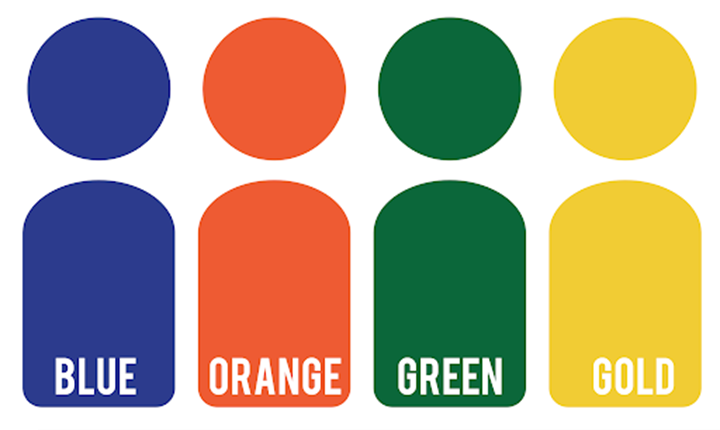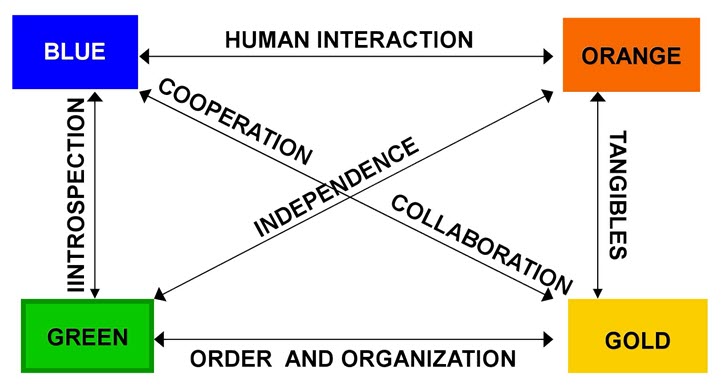
Actual Color is a model for understanding yourself and others based on personality and temperament.
Don Lowry developed the True Colors program in 1979 based on the Keirsey Temperament Sorter, which adapts the 16 Myers-Briggs Types (MBTI) into four Temperaments.
Orange, Gold, Green, and Blue differentiate the four central True Colors personality styles.
Each of us has a combination of the four True Colors that make up our personality spectrum, usually with one of the styles being the most dominant.
True Colors provides insights into different motivations, actions, and communication approaches.
Discovering your primary personality, True Color, can open a window to understanding your behaviors, thoughts, and feelings.
The core of the system identifies intrinsic values:
- Motivations
- Self-esteem
- Sources of dignity and worthiness
- Causes of stress
- Communication styles
- Listening styles
- Non-verbal responses
- Language patterns
- Social skills
- Learning styles
- Environmental motivators
- Cultural appeal
- Negative mental states
- Relationship orientation
- Ethical behaviors
Orange
Orange is often used to promote action, motivation, and excitement.
Orange urges you to PAY ATTENTION – wake up and seize the moment, make quick decisions…take advantage of the immediate opportunity available right now!
Orange encourages a playful atmosphere of activity and movement.
Think of the flash of fire, shimmer of sparklers on the fourth of July, or the flame of a match – hot, dazzling, Orange energy.
Gold
Gold is a color with numerous metaphors associated with it.
Think of the common phrase, “Good as Gold.”
It represents value, stability, and strength.
The expression “Solid Gold work ethic” creates an image of someone responsible… on time, organized, and fulfilling their obligations with stellar dependability, efficiency, and thoroughness.
The classic expression “sets the Gold standard” is also suitable.
Green
Green is an expression of logic – the system of existence and the abundance of this color in nature.
Greens are concerned with the world’s challenges, such as preserving the wisdom of mother earth for the future.
Psychological research has shown the color Green to have a calming effect. In addition, many Greens demonstrate a composed demeanor using mind over emotion to orchestrate and solve the mysteries of life.
Blue
Blue is a color shown to soothe the central nervous system.
It fosters psychological contentment and physical tranquility.
It can be said that when a person feels BLUE, they are experiencing emotional intensity and sensitivity to life dramas.
The figure of speech referring to “True Blues” takes on the meaning of friendship, helpers, “there when you need them,” individuals that will go the extra mile for others.
Appreciating our differences
Appreciating our differences helps us develop better relationships.
Employees often leave their jobs because they feel unappreciated or misunderstood.
The same is true for romantic relationships.
Knowing and respecting others' values can help us to show love to our friends and family.
- Oranges seek recognition and praise.
- Blues desire acceptance and communication.
- Golds need stability and order.
- Greens appreciate the validation of their ideas.
Understanding what frustrates others can also help you avoid missteps and find solutions.
- Golds might refrain from passing judgment or trying to plan for everything.
- Blues can work to resolve conflict rather than avoid it.
- Greens could simplify their ideas for others.
- Oranges can learn strategies to cool their quick tempers.
What Do The Colors Have In Common?
Our unique personality comprises innate characteristics from all four True Colors.
How do the Colors relate to each other, and what characteristics come from which Colors?
A motivator may come from a different Color because of the shared characteristics of the two Colors.
As our understanding of True Colors and ourselves grows, we increase our ability to recognize and tap into characteristics from all four Colors.

Even though Golds and Oranges are dichotomous, they share an interest in tangible things and seeking outcomes with actual results.
Both personality types like having a lovely house, a nice car, and an excellent mate.
They want to be able to see and feel the results of their efforts.
Even though Blues and Greens are dichotomous, they share an interest in having a life with meaning and purpose.
They are reflective individuals who want to make a difference in whatever they do.
Blues and Golds share the desire to work with others collaboratively and cooperatively and form an interconnected and interdependent society.
Greens and Oranges share a desire for independence.
They don’t want to be told how to do something. Instead, they want to decide for themselves what process to follow.
They want to be in autonomous roles governed by self-determination.
Golds and Greens are interested in process and structure and creating order and organization.
They believe that there is a natural order to life and that society will be more successful by identifying the ideal structure and implementing systems to put it in place.
Blues and Oranges have a common interest in people and interpersonal communication.
They must be around people to engage in a robust and highly interactive conversation.
Color Type Development
Your Personality Type has a developmental process that can be observed throughout an individual's life.
The early phases of our lives help determine the order of our four Colors and the development of our secondary Colors.
Our third and fourth Colors are thought to be developed later in life.
From Birth to 6 Years Old
At this early age, we use all four Colors indiscriminately.
We " try on" the different Colors for size, determining which ones work best for us.
Parents may notice trends in behavior that appear to have the characteristics of one or more types.
From 6 to 12 Years Old
During this phase, our first color develops and asserts itself.
If we are Introverted, we do this alone. If Extraverted, we do this through interaction with others.
The first characteristics show themselves as the prevailing aspect of our personality.
From 12 to 20 Years Old
The second Color asserts itself as a powerful support to the first Color.
Since all recent studies point towards the importance of a well-developed team of first AND second Colors, this is an important time of "self-identification."
Research suggests that people without a solid second Color to complement their first Color have real problems.
Since the first Color is an information-gathering Color, the second Color is a decision-making one.
Without a decision-making process, we would flounder and never get anything done! As the second Color comes forth, each person begins to develop the ability to make decisions based on his value system.
This second Color will use the opposite Extraverted/Introverted process as the first Color.
For example, if the first Color is Introverted, the second Color taps into the opposite Extraverted characteristics.
The Introverted/Extraverted characteristic is crucial here because it drives the formation of the third Color, leaving the fourth Color to have the opposite Introversion/Extraversion characteristics of the third one.
At this age, our Color schema is firmly set in place.
From 20 to 35 Years Old
We use our third Color more frequently and with better success.
We continue to make judgments based on the characteristics of our first Color.
Still, we also begin to take action based on personal beliefs rather than depending on the input of others.
This is when the search for the unique self core to who we are begins.
From 35 to 50 Years Old
We pay attention to our fourth Color.
We feel a need to develop it and use it more effectively.
We become more aware of our surroundings and begin to take in information from others in a manner that honors our fourth Color.
We continue to rely on our first Color to take in information, but we are more able to use our fourth Color than we have ever been able to before in our life.
Some researchers have attested that the appearance of our fourth Colors at this phase of life may be responsible for what we commonly call the "mid-life crisis."
From 50 Years Old Onwards
We have access to all four Colors from this age until our deaths.
However, because we live n a society run predominantly by Gold personality types, we use them in a more disciplined, differentiated manner than when we were very young.
Our basic personality type continues to assert itself, but we can call upon all four Colors when needed.